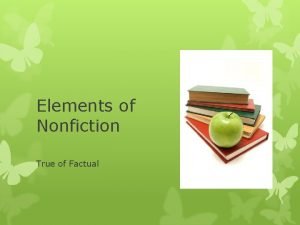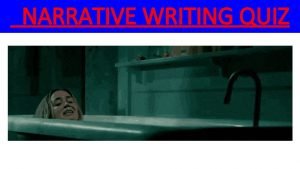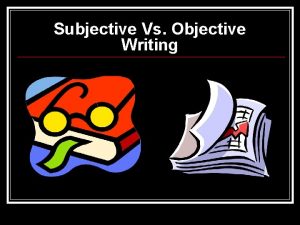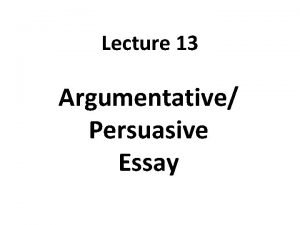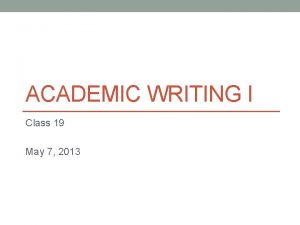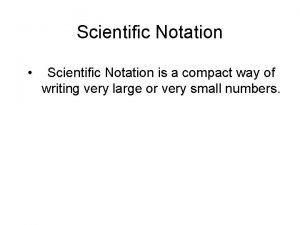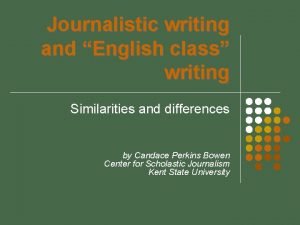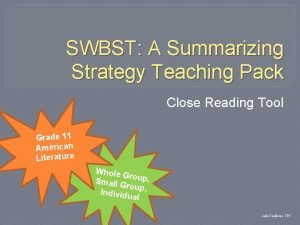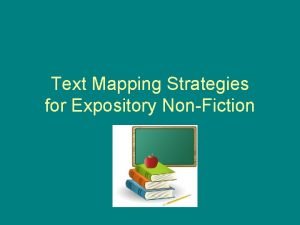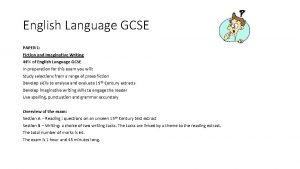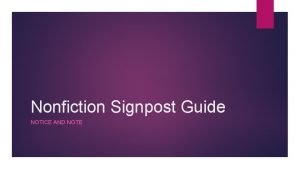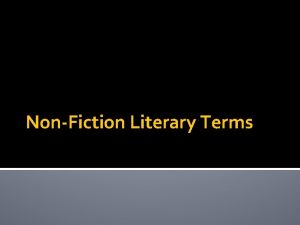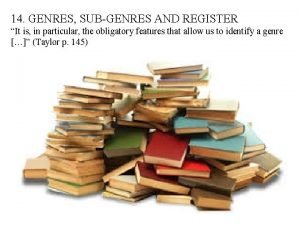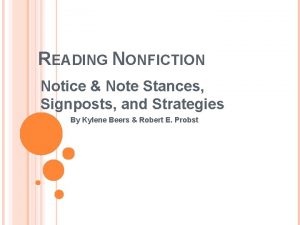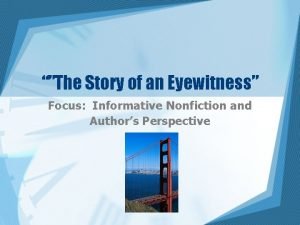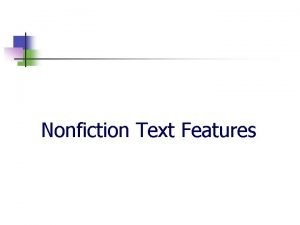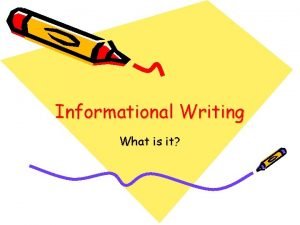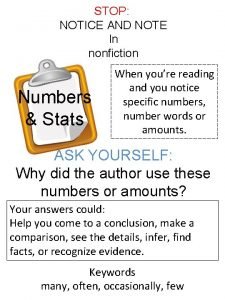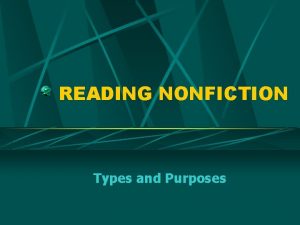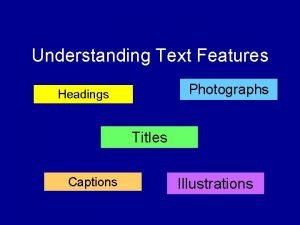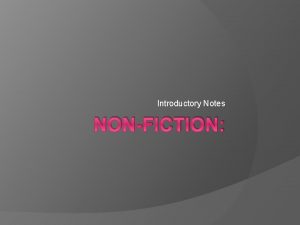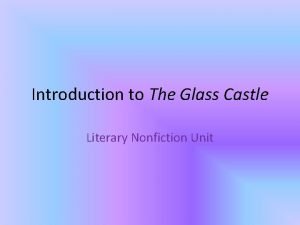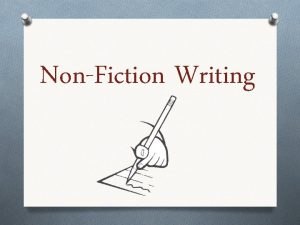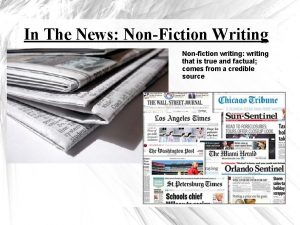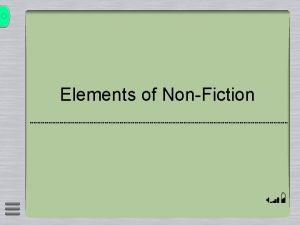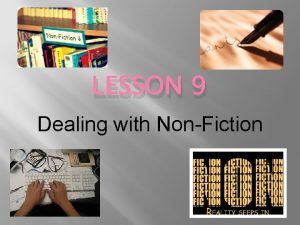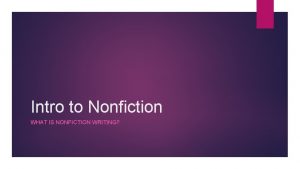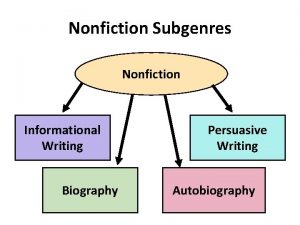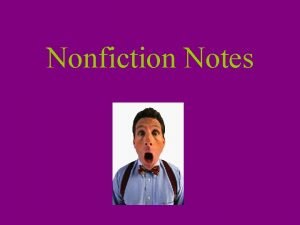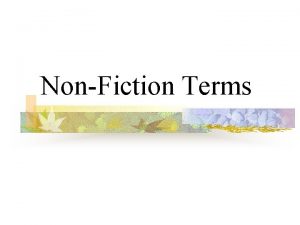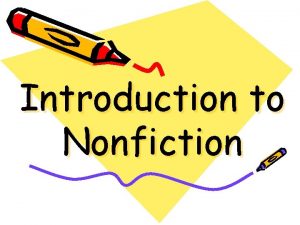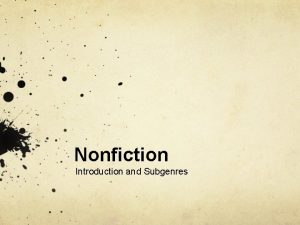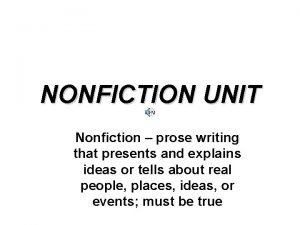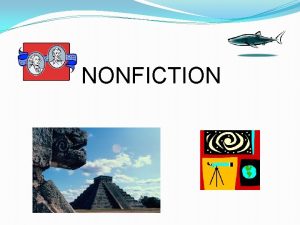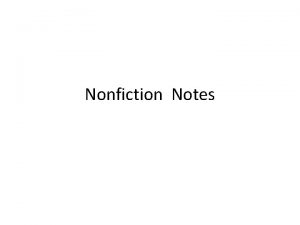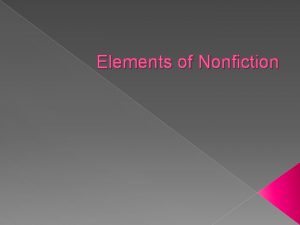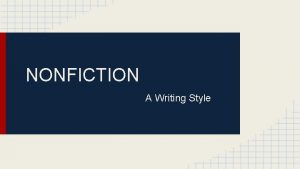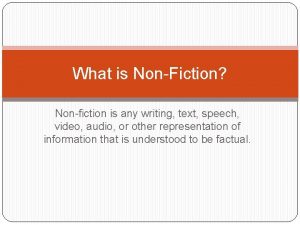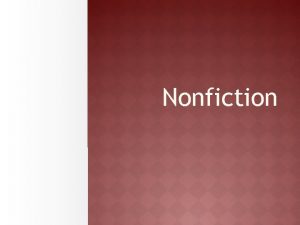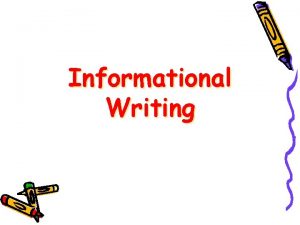Nonfiction What is Nonfiction Nonfiction is writing that









































- Slides: 41

Nonfiction

What is Nonfiction? • Nonfiction is writing that is based on real people, places, objects, or events. Can you think of any examples of nonfiction? • Newspapers- feature information and facts that are current and important to readers. • Historical documents- are papers that have significance in affecting the past such as “The Declaration of Independence” • Essays- are pieces of writing that are based on facts or experiences and may serve to persuade, inform, or entertain readers.

Analysis of Non-fiction How does Non-fiction text look different than fiction? How are pictures used? How is the vocabulary different? • There may be chapter titles and section headers that preview information. • Each page has words in a variety of fonts and type sizes. • Bold or italic fonts may be used to signal important words or phrases. • Maps, charts, diagrams, photographs are usually included to illustrate or summarize information. • Captions or labels must be examined carefully for relevant information. There may be more words that are unfamiliar. Look for words that may be difficult to pronounce.

Become T. H. I. E. V. E. S… T H Title- This is your introduction to the text. Headings- Read all of the headings. They give you insight in to the main idea of each section. I Introduction- Offers background information into the subject area. It provides a framework to what the entire article will be about. E V E Every first sentence in each paragraph- These are often the topic sentences and tell you what the reading will be about. S Visuals and Vocabulary- Look for visuals as well as any vocabulary that is unfamiliar to you. End of Chapter questions- Read any questions and try to answer any questions that are presented. Summarize- If you can successfully summarize what you have read, then you have been an active reader.

Author’s Purpose • Every writer has a purpose, or reason, for writing. A good reader will determine the author’s purpose for writing, which will help in understanding the passage. There are typically 3 main reasons author’s write. • http: //learningupgrade. com/compup/index. htm PIE • Persuade • Inform • Entertain

To Entertain or not to Entertain? The author wants to entertain the reader if: • The passage is enjoyable • The passage is a personal story • The writing is a short story, novel, or some other form of fiction.

Are you informed? The author wants to inform or educate the reader if: • The passage has a lot of facts about a subject. • The passage includes charts, graphs, maps • The passage is non-fiction

Are you persuaded yet? The author wants to persuade the reader if: • The passage includes many opinions • The passage encourages the reader to act or think a certain way • The passage is an advertisement, editorial, pamphlet, etc.

Guess the Author’s Purpose! 1. An event calendar in the newspaper. To inform 2. An issue of Superman comics. To entertain 3. An encyclopedia article about Africa To inform

Try these on your own… To persuade • A brochure for Disney World To entertain • A scary monster story • A letter to the editor of a newspaper about recycling. To persuade • A chapter in a science textbook about the To inform solar system.

Additional Practice… • http: //fcit. usf. edu/FCAT/strategies/ap/activi ty 2. htm • Homework- Look through a newspaper or magazine and find 3 examples of each type of author’s purpose (to inform, persuade, or entertain). Bring in your three types in for class tomorrow.

Warm Up 1/8/09 • Sharpen Pencils and write down homework. • Take out your grammar workbook homework. • Pull out your “Caught Ya” from the notebook.

Caught Ya Underline the subject. hilda the mean lady could no longer stand hairy’s repulsive warty visage Visage Appearance

Commas • Rule #1 - appositives • Rule #2 - between coordinate adjectives Coordinate Adjectives • If two adjectives modify a noun in the same way, place a comma between the two adjectives. These are called coordinate adjectives. Example: Did you read about Macomber's short, happy life?

Two Tests • There is a two-part test for coordinate adjectives: – (1) Can you replace the comma with the word and? – (2) Can you reverse the order of the adjectives and keep the same meaning? • If you can do both, then you have coordinate adjectives. • Correct: Did you read about Macomber's short, happy life? • Test for Correctness: Did you read about Macomber's short and happy life? – Did you read about Macomber's happy, short life?

Author’s Purpose Game • Each group has a deck of cards with different paragraphs on them. • Leave the cards turned down until it is your turn. • Starting with the first player, pull the top card off of the deck. • Read the paragraph aloud to the group and then state the author’s purpose. • If you get it correct, you keep the card, however if it is incorrect, return the card to the bottom of the deck. • The person with the most cards at the end of the game wins the games (and entitled to BLUES tickets!)

Warm Up 1/9/09 • Sharpen Pencils and write down homework. • Take out your grammar workbook homework. • Pull out your “Caught Ya” from the notebook.

Caught Ya 01/09/09 so she wrote him hairy beast a nasty vituperative letter to tell him of her feelings (8 mistakes) vituperative Harsh language

Caught Ya 01/12/09 4321 rue street hogtown florida 32609 january 12 2009 (7 mistakes) rue Sorry or regret

Complete Subjects and Complete Predicates The complete subject of a sentences includes the simple subject and the words related to it. The complete predicate includes the verb (simple predicate) and the words related to it. http: //classroom. jc-schools. net/la/activities/subjpred_files/frame. htm http: //suzyred. com/subjects. html

Examples • The complete subject is who or what is doing the verb plus all of the modifiers [descriptive words] that go with it. Read the sentence below: – The big, hungry, green Martian grabbed a student from the back row. • Who did the grabbing? The Martian, of course. But this Martian wasn't petite, satisfied, and blue. No, this one was big, hungry, and green. The complete subject, then, is the huge, hairy, hungry, green Martian.

Complete Predicate Includes all the words in the predicate. Complete Subject Complete predicate – The big, hungry, green Martian grabbed a student from the back row. Try these: Draw a straight line between the complete subject and complete predicate. 1. Babbage imagined a printing device for his machine. 2. Then, the machine could not print the answers.

On a sheet of paper draw this graphic organizer. “The Shoutout” By: Patricia Mc. Kissack Who? What? Where? When? Why? How?

Read the selection below. Who? What? Where? It is accepted that by 1845, When? baseball, as it is recognized today, was becoming popular, especially in New York. In that year a group of baseball enthusiasts organized the New York Knickerbocker Club. How? They tried to standardized the game by establishing guidelines for “proper play. ” Why?

Now Try on Your Own… • Read the text entitled “American vs. British Teeth. ” • Underline the “who, ” “what, ” “where, ” “how, ” and “when” using different colored pencils. – – – Use red for “who” Use blue for “what” Use yellow for “where” Use green for “how” Use purple for “when”

Framed Summary Often times when a reader comes across new information that contains a lot of details, it is important to be able to distinguish which facts support the main idea of the passage. After using an outlining strategy, it is helpful to organize information and write a summary of the nonfiction piece.

Remember that article on Baseballs? ? ? Title of Selection “The Shutout” Tell about the beginning of the middle of the article Tell about the end of the article “The Shutout” begins telling about the origin of baseball. This established guidelines for “proper play” The baseball enthusiasts organized the New York Knickerbocker Club.

Here’s what my framed summary would look like: “The Shutout, ” written by Patricia C. Mc. Kissack is a riveting biography of baseball as we know it today. Baseball began in the late 1800’s and continues to exist today. Because of the high interest in baseball, the New York Knickerbocker Club was established. Through its’ efforts, standard guidelines for “proper play” were established.

Did I include everything? Title of Selection Tell about the beginning of the article Tell about the middle of the article Tell about the end of the article “The Shutout” by Patricia C. Mc. Kissack “The Shutout” begins telling about the origin of baseball. The baseball enthusiasts organized the New York Knickerbocker Club. This established guidelines for “proper play” “The Shutout, ” written by Patricia C. Mc. Kissack is a riveting biography of baseball as we know it today. Baseball began in the late 1800’s and continues to exist today. Because of the high interest in baseball, the New York Knickerbocker Club was established. Through its’ efforts, standard guidelines for “proper play” were established.

Now You Try… • Using the article “American vs. British Teeth, ” fill out your Reading Focus Lesson Framed Summary. • After you have finished, begin your summary.

Caught Ya 01/15/09 hairy beast hildas lover recieved his odious letter on january 15 2009 (9 mistakes) odious Hateful; highly offensive

Active Reading Behaviors Good readers do the following things while reading: (GMAG- Give Ma A Gift) • Gather Facts: Jot down things that are interesting and new to you. • Make Connections: Relate and compare things you are reading to things that you already know. • Ask Questions: What about the reading is confusing to you? What don’t you understand? How will you find the answer? Remember that there will always be questions in an active reader’s mind! • Give Opinions: Make judgments about what you are reading. Do you agree? Do you disagree? Like? Dislike? Do you support or oppose anything that you have read? Why?

Caught Ya 01/22/09 he cried copious tears tore out tufts of green fur and demolished his apartment like a wild beast (4 mistakes) copious In abundance

Independent Clause • An independent clause has a subject and a verb and can stand by itself as a complete sentence. – Example: The ski lift took us up to the mountain. – Lance Armstrong, an American cyclist, won the Tour de France.

Try these… • The library has a new computer. • Last week, it rained every day.

Use the following sentence starters to shape your thoughts and comments while reading. This reminds me of… • This is similar to… • I wonder… • I realized… • I noticed… • You can relate • I’d like to know…

“Worst Ice Storm Grips America” A chilling ice storm has gripped huge areas of north east America, cutting off power to more than a million homes. At least four people have died and lots of homes and schools have been damaged, in what’s being described as one of the worst ice storms in 10 years. States of emergency have been declared in Massachusetts, New Hampshire and parts of Main and New York state. People are being warned the big freeze looks set to continue and it could be days before they get power back. Ice storms happen when rain falls when it’s very cold, freezing, as soon as it hits a surface. The ice can coat huge areas at a time and be so heavy that trees can collapse under its weight. By declaring states of emergence, officials can get more help to deal with the ice and the devastation it’s causing.

I wonder what states are involved. Let’s annotate… A chilling ice storm has gripped huge areas of north east America, cutting off power to more than a million homes. At least four people have died and lots of homes and schools have I wonder been damaged, in what’s being described as one of the worst where the ice storms in 10 years. last storm States of emergency have been declared in Massachusetts, New was. Hampshire and parts of Main and New York state. People are being warned the big freeze looks set to continue and it could be days before they get power back. Ice storms happen when rain falls when it’s very cold, freezing, as soon as it hits a surface. The ice can coat huge areas at a time and be so heavy that trees can collapse under its weight. By declaring states of emergence, officials can get more help to I wonder is deal with the ice and the devastation it’s causing. Is the same “State of Emergency” as in 911? this common in the Arctic Circle.

Now You Try… • Using your article “American Teeth vs. British Teeth” create 7 annotations. • I have provided the sentence starters below. • This is similar to… • I wonder… • I realized… • I noticed… • You can relate • I’d like to know…

Bias and Semantic Slanting • Bias- favoring one side/group over another. • Example: Ligon Middle School is the best school in Wake County. • Can you think of another example? • Semantic Slanting- using language to influence thought. Deliberately choosing words to create specific emotional responses. • “The main reason I believe Sweden claims neutrality now is that it flat can not afford otherwise. There is a lot of military machinery in clonflcits around the world with “Made in Sweden” stamped on them. ”

Primary Source vs. Secondary Source • Primary Source- An original source that shares firsthand knowledge and the information can be traced no further than its author. • Example: Personal Interview with a sports trainer • Secondary Source: A source that shares information that has been collected, compiled, summarized, and maybe even changed from the original source. • Example: A survey about favorite sports
 Tôn thất thuyết là ai
Tôn thất thuyết là ai Phân độ lown
Phân độ lown Chiến lược kinh doanh quốc tế của walmart
Chiến lược kinh doanh quốc tế của walmart Gây tê cơ vuông thắt lưng
Gây tê cơ vuông thắt lưng Block nhĩ thất cấp 1
Block nhĩ thất cấp 1 Tìm độ lớn thật của tam giác abc
Tìm độ lớn thật của tam giác abc Sau thất bại ở hồ điển triệt
Sau thất bại ở hồ điển triệt Thơ thất ngôn tứ tuyệt đường luật
Thơ thất ngôn tứ tuyệt đường luật Con hãy đưa tay khi thấy người vấp ngã
Con hãy đưa tay khi thấy người vấp ngã Thơ thất ngôn tứ tuyệt đường luật
Thơ thất ngôn tứ tuyệt đường luật Elements of nonfiction
Elements of nonfiction Triangle composition
Triangle composition Formal writing vs informal writing examples
Formal writing vs informal writing examples Passive voicew
Passive voicew Narrative quiz
Narrative quiz Argumentative essay vs expository essay
Argumentative essay vs expository essay Is writing subjective
Is writing subjective Persuasive vs argumentative
Persuasive vs argumentative Business writing vs academic writing
Business writing vs academic writing 7x10x10x10
7x10x10x10 Types of informal writing
Types of informal writing Similarities of types of journalistic writing
Similarities of types of journalistic writing Swbst strategy example
Swbst strategy example Nonfiction reading test black friday
Nonfiction reading test black friday Nonfiction deals with facts.
Nonfiction deals with facts. What is expository nonfiction
What is expository nonfiction Is english language paper 1 fiction or nonfiction
Is english language paper 1 fiction or nonfiction Nonfiction signpost examples
Nonfiction signpost examples Types of nonfiction prose
Types of nonfiction prose Nonfiction literary terms
Nonfiction literary terms Bag lunch by dillard perkins
Bag lunch by dillard perkins Notice and note nonfiction
Notice and note nonfiction Informative nonfiction
Informative nonfiction What is a sidebar in nonfiction text
What is a sidebar in nonfiction text Informational nonfiction definition
Informational nonfiction definition Numbers and statistics signpost
Numbers and statistics signpost Types of nonfiction
Types of nonfiction Photograph text feature
Photograph text feature Objective facts
Objective facts Roman has 2 red pencils in his backpack
Roman has 2 red pencils in his backpack Joshua tree symbolism in the glass castle
Joshua tree symbolism in the glass castle Expository text vs functional text
Expository text vs functional text










